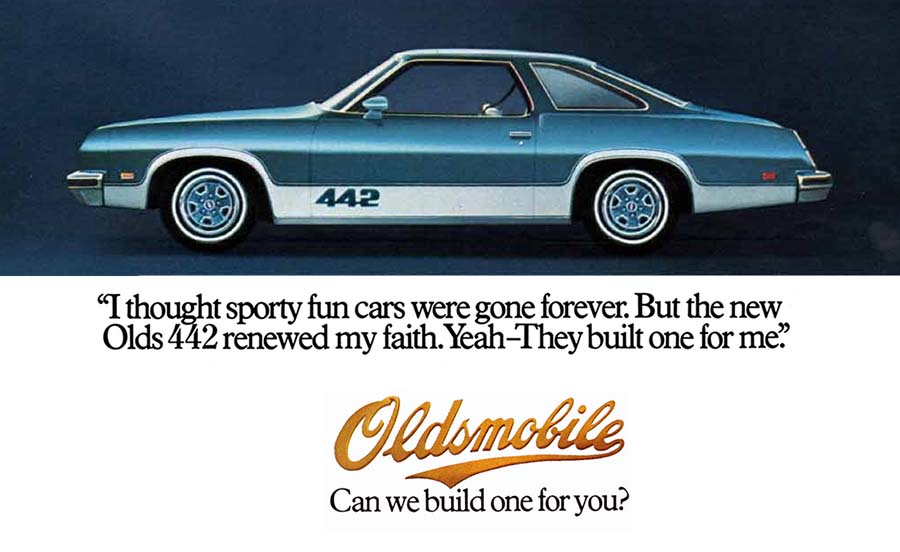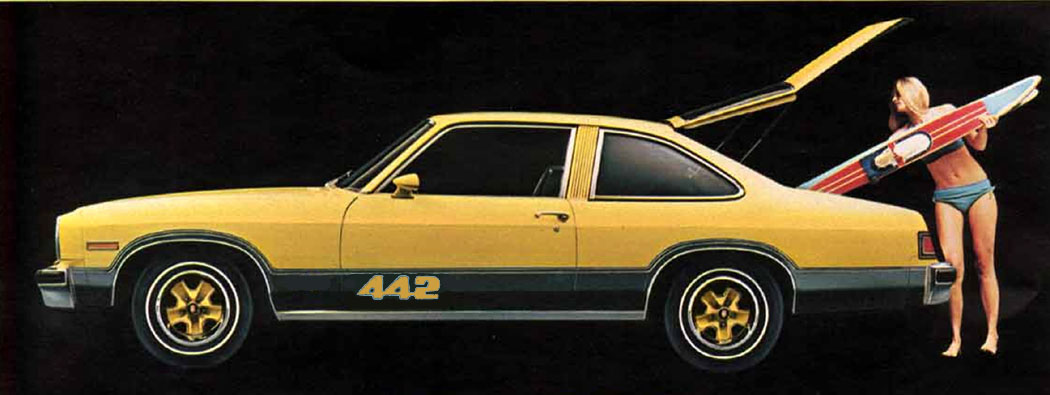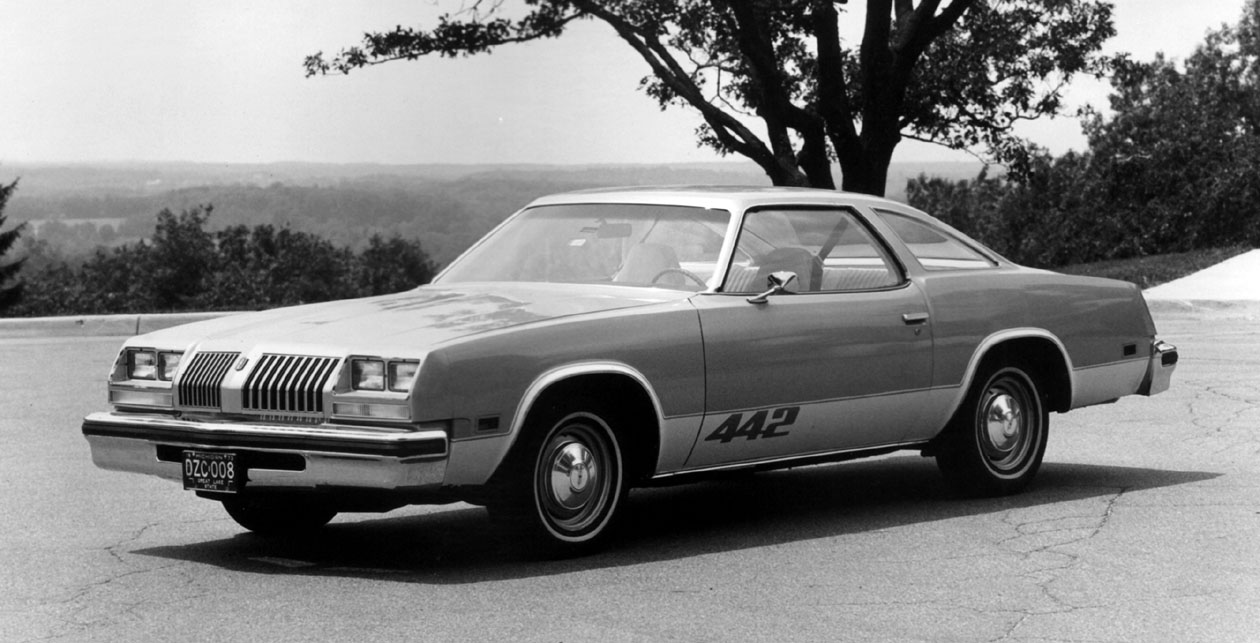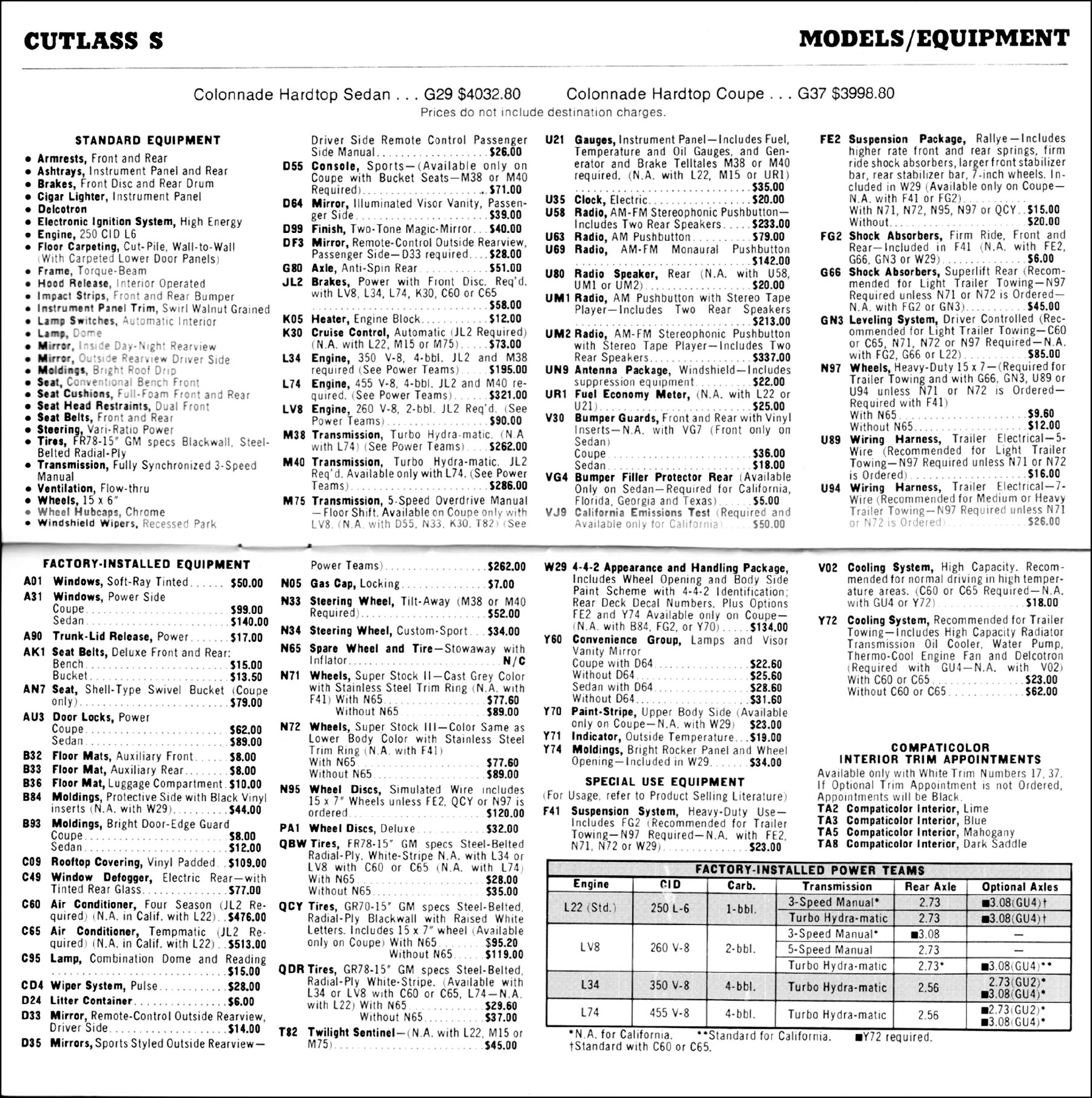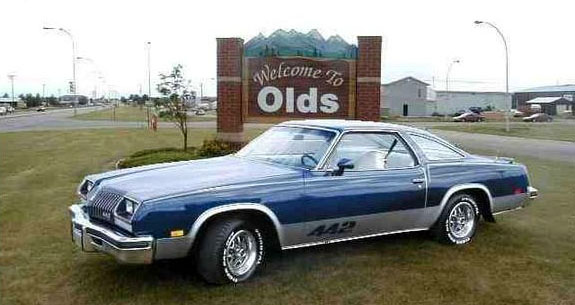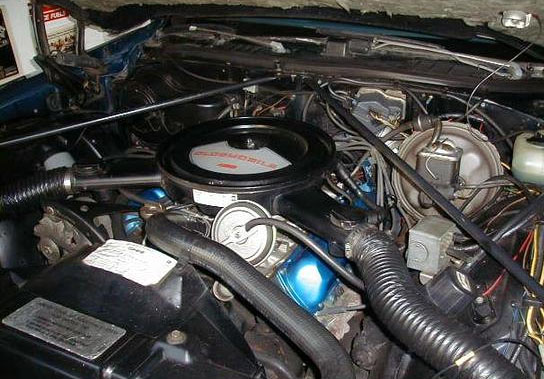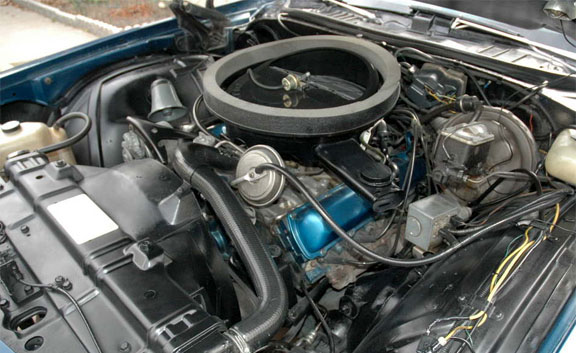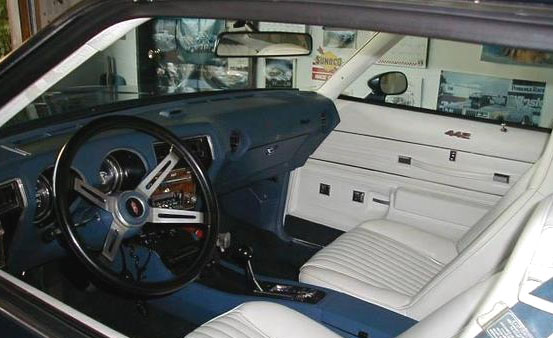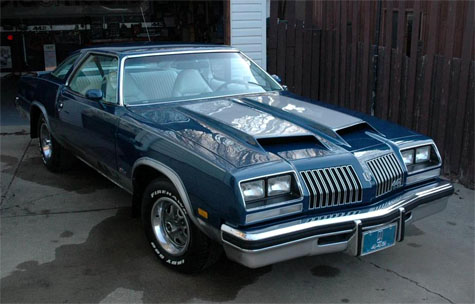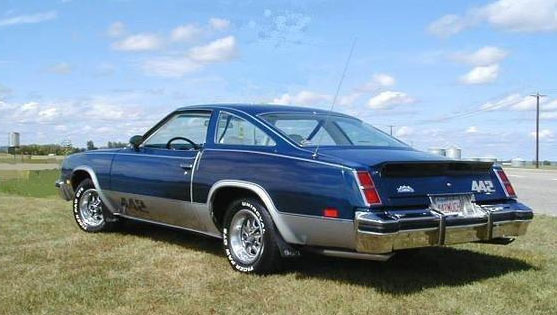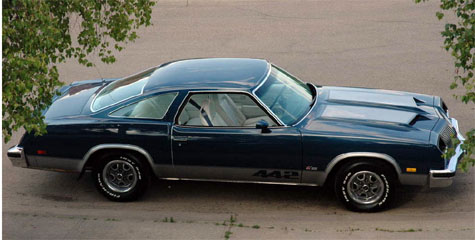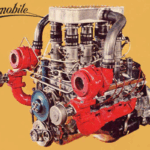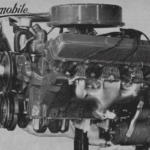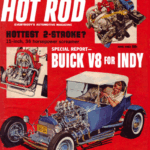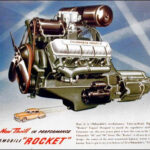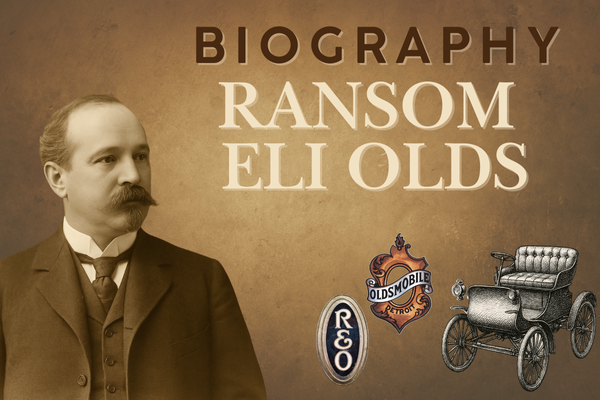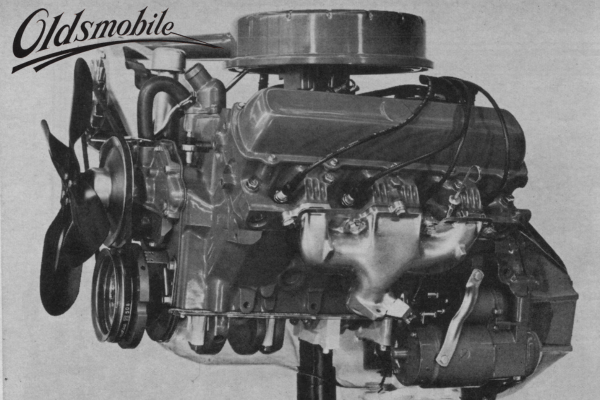Have One Built For You? No Easy Task in 1976. First there was the EPA and DOT . . . and then there was a gas crisis . . .
Detroit was struggling with the mandated crash and emissions regulations in the mid 70’s and they were not fairing well. They had designed big heavy cars with styling that did not meld well with 5 mph impact bumpers. They were working with engines brought to life before the thought of controlling hydrocarbon and nitros oxide output. And then along came the gas crunch!
400+ cubic inch V-8s suddenly seemed archaic; 3800 pound cars seemed slothful; performance began to slant toward gas mileage & smaller vehicles. Oldsmobile was caught up in this conundrum – as a luxury car maker, they wanted to put medium and large size vehicles in the hands of their buyers, but the bigwigs at GM were folding under the pressure to deliver cars to compete with the newly emerging Japanese manufacturers.
What to do? Olds product planners pressed for the abolition of the B and C Body, with the A-Body being renamed as the 88 and 98 and the X Body taking on the Cutlass Moniker. The Omega nameplate would be dropped, and the new Starfire would slot in as the entry Oldsmobile. I shudder to think how close we came.
Marketing was ready to go forward and Styling was on board too. In fact, the “SX” graphics had been replaced with the “442” See the “SX” rebadged at right as a “442”. This is why the 76 Omega SX had such similar body paint – Scary). All was a “go” until the NOVA X-Body plant told Olds that there was no way they could meet the expected Cutlass production needs. Whew!
It was at this point that the new B-C and G bodies were given the green light for 1978 and the 455 was slated to receive the axe. Meanwhile, the plans laid down back in 1972 for the 1976 Olds line were dusted off and put into production.
But the handwriting was on the wall – 1976 and 77 would be a holding battle while the new, smaller cars were finalized and made ready for production.
Enter the 1976 442
Considering the pressure, it is a wonder that the 442 existed at all. Each year from 1971, the car had been dwindling in Oldsmobile’s product line and in its advertising. The Cutlass/442 restyle actually came off quite well, with the 2-door cars receiving the new sloped front fascia and quad headlights and a more racy rear deck and taillight housing. Styling scrambled around and the SX and 442 got to share similar graphics.
Initially the 442 was going to be those graphics and that would be it (see the picture on the right). It was not exactly going to a hell-raiser and that photo does well to be in grayscale, because it was pretty bland.
But something happened, and perhaps we’ll never even know why – Olds decided to let the buyer option a 442 anywhere from a putt-putt grocery getter to a real performance piece. And most interestingly, they let the buyer select from a quite extensive list of options.
In fact, Olds even touted the buyer’s ability to have one “built for me”. Most importantly, one could build a 442 with some getup and go (1976 style). Grabbing the order form one could start out with the following:
- W-29. The 442 package was labeled an “outside appearance and handling package”, and that was it. But you could then order the
- L-74. the venerable 455 4 barrel with a the optional 3.08 “performance” gear, but G80 anti spin was available (Californians were stuck with a 2.56 gear – sorry guys).
- M-40. The T400 auto was mandatory – and that was a good thing, so at least one had a good base.
And much like when the 442 was first offered back in the early 60s, everything else required a checkbox tick, but with a little judicious shopping (see the salesman’s spec book at right) one could end up with . . . a performance car!
Now, let’s face it, the cat-conned, single pipe 455 was not the same 455 offered even in 1971-73, but with a bit of playing after you left the dealer – it could deliver some grunt. Remember, most States didn’t have any sniffers and many cars like the 442 were immediately converted to cat-less dual exhausts.
What else could you get? Considering the time and the fact that this A-Body almost wasn’t a Cutlass, not to mention a 442, there was a lot available. In addition to the 455, M40, and FE2, you could get:
- AN-7 swivel buckets
- D-35 sport mirrors
- D-55 console and shifter
- G-80 anti-spin axle (dealer installed ratios up to 5.00)
- N-34 custom sport steering wheel
- N-71 & N-72 Super Stock II and III (argent or color-matched) wheels
- QCY GR-70 raised white letter radials
- U-21 gauge pack
- Y-72 heavy-duty cooling
With the right choices and a little “aftermarket” and dealer-installed tweaking, you really could build a true 442.
The Ken Pilidis 1976 442
Right away we want to say that the L-74 442 was a rare bird in 1976, with only 143 built, period. When you couple that with the fact that Ken’s car was imported into Canada, that makes it even more rare. Ken has information that his car is the only one left of 6 cars that were sent there in 1976. To his knowledge, only 13 of the original total 143 cars exist in the US today, making this car as rare as the 1966 W-30!
Ken purchased the car second-hand in 1979 where it had only had one other owner. Ken says: “I bought this car in March of 1979. The car had 29,000 miles on her and a price tag of $5,000. It was fully loaded and was in great shape”.
He drove the car and kept it up, adding a piece here and there until 1987 when he decided that it needed a repaint. He went with the original color scheme, but the body shop used Standox paint and, Ken said that their code 35 was a darker color that the original. The picture at left shows the car after the repaint.
Ken kept adding stuff and finally in 2008 he decided to take the car down to bare metal and add that neat-looking ram air hood and 70’s OAI adapter. Take a look a the pictures of the process on the right. He had also added the NASCAR rear spoiler and to my mind, this really makes the car when viewed from the rear. This time, Ken was able to get the color just right, and when coupled with the rally stripes on the hood, the car came off terrific.
We tend to think of these cars as “new” compared to the earlier cars, but remember, this car was 32 years old when it was redone – and it faced Canada winters! Ken says: “I decided to have the old hood done as well in case I want to go back to original in the future. This time the paint match was exact. There was one spot where rust was found but that was nipped in the bud.” The car still has all its original body panels. Simply amazing.
Here are some vital statistics on Ken’s 1976 442: Built on March 1, 1976 in Lansing. Sold at Crowsnest Pass Motors, Blairmore, Alberta, Canada on March 26, 1976. It was equipped with the L-74 455 cubic inch V-8 with Quadrajet, T-400 with console and swivel bucket seats. On the outside it had Sport Mirrors and15″ x 7″ Superstock II wheels. The exterior was Dark Blue Metallic with Silver Stripe and the interior was White with TA3 compaticolour (blue) trim.
When Ken acquired the car it had some neat, dealer installed options. It seems that the original buyer wouldn’t take possession of the car unless it was upgraded with some earlier high performance parts. In order to sell the car, the dealer added GU-6 anti-spin axle ratio 3.42, W-26 Hurst Dual Gate Shifter, and W-30 W455 aluminum intake and W exhaust manifolds Code “X” and “Z”. Surprisingly, it retained the single pipe sans cat-con (Canada cars could be fitted this way in 1976, option N-95).
Ken has added a bunch of options beyond the delivered add-ins:
- Engine rebuilt to 9.75:1 Compression with ported “C” heads; true 2..25″ dual exhaust with Walker Super Turbo Mufflers
- W-25 Outside Air Induction Hood
- W-27 aluminum differential cover; W-35 rear deck lid spoiler
- WW-8 Hurst/Olds Digital Tachometer
- Y-70 upper body stripe
Ken reports that the trusty 455 now delivers 435 HP and 550 ft. lbs of torque and that the car turns the quarter mile in the high 13s.
Back in 1997 Ken’s car was chosen by Oldsmobile Division to represent the year 1976 in the Oldsmobile Centennial Parade in Lansing, Michigan along with a 1976 Toronado and a 1976 Delta 88. It’s not surprising, because this car is one head turner.
I guess Ken followed the advice in the 1976 ads and “had one built for him”. Oldsmobile had the right idea back then, they just didn’t have the means to fully execute – Ken Pilidis does . . . and he did.
Ken Pilidis followed the lead of the 1976 Ad for the 442 when he restored his car.
He had it built for him the way the Factory should have done it!
1976 Oldsmobile 442 Image 2
This composite from the 1976 Oldsmobile Brochure carries the theme – can we build one for you?”
1976 Oldsmobile 442 Image 3
Note the SX paint scheme on the Omega and it’s similarity with that of the 442. See how nice the “442” would have looked there – it almost happened!
1976 Oldsmobile 442 Image 4
AN-7 swivel buckets were good-looking pieces when set off by the D-55 Console. (green would not be the best choice of interior trim however.
1976 Oldsmobile 442 Image 5
As this PR Photo shows. Olds was not that enamored with the 442. Showing a car with “dog dish” hubcaps in an obviously bland color (even in black and white) did not make this car pop.
1976 Oldsmobile 442 Image 6
Take a look at this option list. Considering the year and the pall hanging over Detroit at the time, this ain’t bad.
1976 Oldsmobile 442 Image 8
Ken’s car before the repaint and the hood seen on above. The color choice really works on a 1976.
1976 Oldsmobile 442 Image 9
Ken’s car before the repaint and the hood seen on above. The color choice really works on a 1976.
1976 Oldsmobile 442 Image 12
When Ken did the car over in 2008, he went to bare metal. The results show it.
1976 Oldsmobile 442 Image 13
Laying paint on the W-30 hood. Even at this point, you can tell it is going to be a looker.
1976 Oldsmobile 442 Image 15
. . . and going this is one beautiful car. And at the high 13s in the quarter it can go too!



